Original Title: "Stablecoins 101: Behind crypto’s most popular asset"
Source: Chainalysis
Translation by: Bai Shui, Golden Finance
Stablecoins have quietly become a powerful force in the global cryptocurrency market, accounting for more than two-thirds of the trillions of dollars in cryptocurrency transactions recorded in recent months.
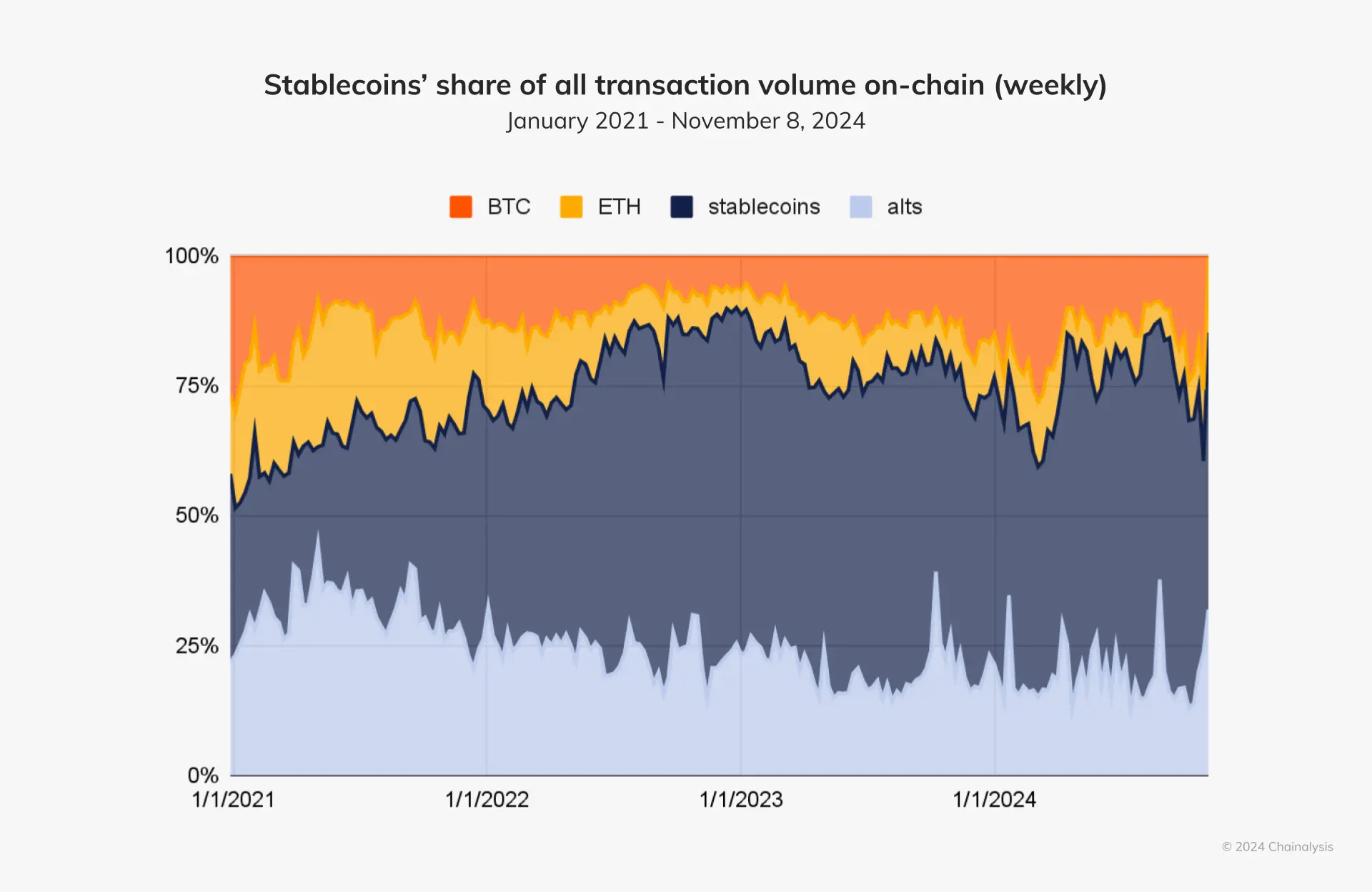
Unlike most cryptocurrencies, which often experience extreme price volatility, stablecoins are pegged to less volatile assets, such as fiat currencies or commodities, at a 1:1 ratio to maintain a consistent and predictable value.
Globally, stablecoins are gaining momentum as a medium of exchange and a means of value storage, filling the gaps left by traditional currencies, especially in regions with currency instability and limited use of the US dollar (USD). Businesses, financial institutions (FIs), and individuals are leveraging stablecoins for various use cases, from international payments to liquidity management and hedging against currency fluctuations. Compared to traditional financial systems, stablecoins facilitate faster and more cost-effective transactions, accelerating global adoption.
As regulatory momentum around cryptocurrencies continues to grow, stablecoins are becoming a focal point in discussions about technologies shaping the future of finance.
What are Stablecoins?
Stablecoins are programmable digital currencies typically pegged 1:1 to fiat currencies like the US dollar. They are primarily issued on networks such as Ethereum and Tron, combining the powerful capabilities of blockchain technology with the financial stability required for practical use cases of cryptocurrencies.
The launch of Bitcoin in 2009 revolutionized the world’s financial infrastructure by introducing a decentralized peer-to-peer trading system that eliminated the need for intermediaries. However, its limited supply and speculative trading dynamics led to extreme price volatility, making its native token, Bitcoin (BTC), difficult to use as a medium of exchange. Similarly, when Ethereum emerged a few years later, it built on Bitcoin's foundation, extending the functionality of cryptocurrencies to programmability through smart contracts. This innovation spurred the rise of decentralized finance (DeFi), but like Bitcoin, Ethereum's native token, Ether (ETH), also suffered from significant price fluctuations.
Stablecoins first appeared in 2014, combining the technological advantages of blockchain (such as transparency, efficiency, and programmability) with the financial stability needed for widespread adoption. By addressing the issue of cryptocurrency price volatility, stablecoins unlocked new use cases beyond trading and speculation, attracting a broad range of cryptocurrency users, including retail and institutional users.
Types of Stablecoins
Stablecoins maintain their value through various mechanisms designed to ensure price stability.
Fiat-Collateralized Stablecoins
Fiat-collateralized stablecoins are the most popular type of stablecoin, pegged to the value of traditional currencies at a 1:1 ratio, with the US dollar and the euro (EUR) being the most common benchmarks. The stability of these stablecoins comes from reserves held in fiat currencies or equivalent assets, which serve as collateral. Examples include Tether (USDT) and USD Coin (USDC), both pegged to the US dollar, and Stasis Euro (EURS), pegged to the euro.
Commodity-Collateralized Stablecoins
Commodity-collateralized stablecoins are pegged to the value of physical assets such as gold, silver, or other tangible commodities. These stablecoins allow users to gain exposure to commodity investments without directly owning the commodities. For example, PAX Gold (PAXG) is a stablecoin backed by gold reserves, with each token representing one troy ounce of gold stored in a secure vault. Another example is Tether Gold (XAUT), which similarly offers gold-backed stability.
Cryptocurrency-Collateralized Stablecoins
Cryptocurrency-collateralized stablecoins are backed by reserves of other cryptocurrencies. These stablecoins often use over-collateralization (i.e., the value of assets held in reserve exceeds the pegged value) to mitigate the inherent volatility of their underlying assets. For instance, Dai (DAI) is backed by cryptocurrencies like ETH and maintained through a system of smart contracts within the MakerDAO protocol. Users deposit collateral to mint Dai, ensuring its stability, even as the collateralized cryptocurrencies experience volatility.
US Treasury-Collateralized Stablecoins
US Treasury-collateralized stablecoins, such as USDY from Ondo and USYC from Hashnote, differ from traditional fiat-backed stablecoins supported by cash reserves or liquid assets. Backed by US Treasury bonds and repurchase agreements, they provide yields directly to holders, essentially acting as tokenized money market funds and attracting investors seeking safety, passive income, and regulatory compliance.
Algorithmic Stablecoins
Algorithmic stablecoins maintain their value through programmed mechanisms that adjust supply based on market demand, without relying on direct collateral. Examples of algorithmic stablecoins include Ampleforth (AMPL), which dynamically adjusts its supply to stabilize prices, and Frax (FRAX), a partially algorithmic stablecoin that combines collateral with algorithmic adjustments. Ethena's USDe is a synthetic stablecoin pegged to the US dollar, using crypto assets and automated hedging to maintain its dollar value without directly holding fiat currency. While these models are innovative, they face challenges in maintaining long-term stability, as seen in the collapse of TerraUSD (UST) in 2022, highlighting the risks associated with purely algorithmic stabilization mechanisms.
Stablecoins in the Cryptocurrency Market
Beyond speculation, stablecoins play a crucial role in the cryptocurrency market, providing a reliable medium of exchange, value storage, and a bridge between TradFi and cryptocurrencies. As significant liquidity providers, stablecoins underpin much of the activity in decentralized finance (DeFi), centralized exchanges (CEX), and cross-border payments.
As we see below, the stablecoin market has matured globally, replacing BTC as the preferred asset for everyday transactions.
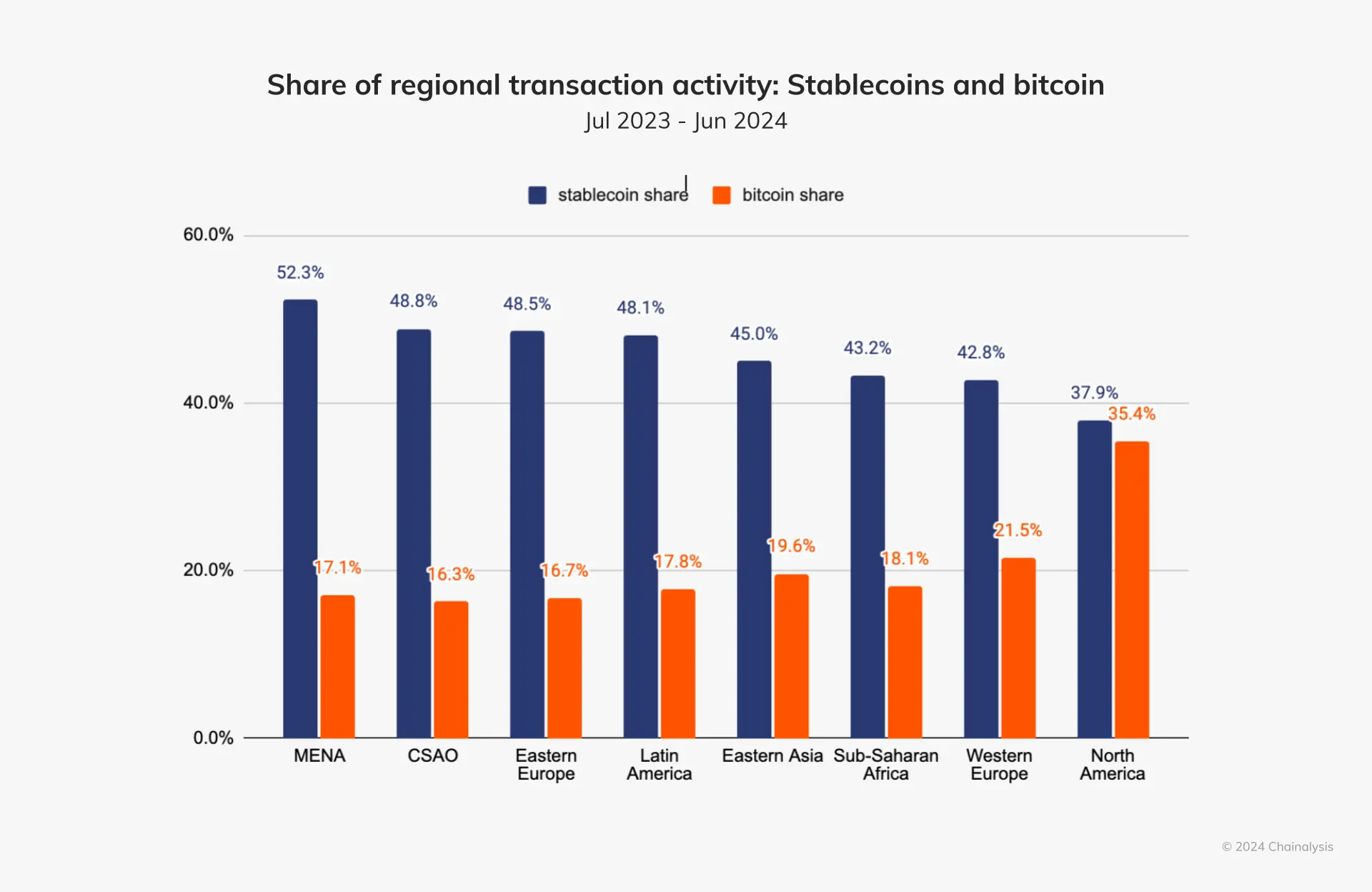
Regions such as Latin America and Sub-Saharan Africa are embracing stablecoins as a means to hedge against local currency instability, providing more reliable means of transaction and value preservation. In these areas, retail adoption of stablecoins is primarily driven by their utility for low-cost remittances, safe savings in currency-volatile regions, and access to DeFi services like lending and staking.
While stablecoins are increasingly popular among institutions, much of their growth is driven by transfers under $1 million—our benchmark for non-institutional activity, which we studied in our annual cryptocurrency geography report. Below, we examine the growth of retail and professional-scale stablecoin transfers from July 2023 to June 2024 compared to the same period last year.
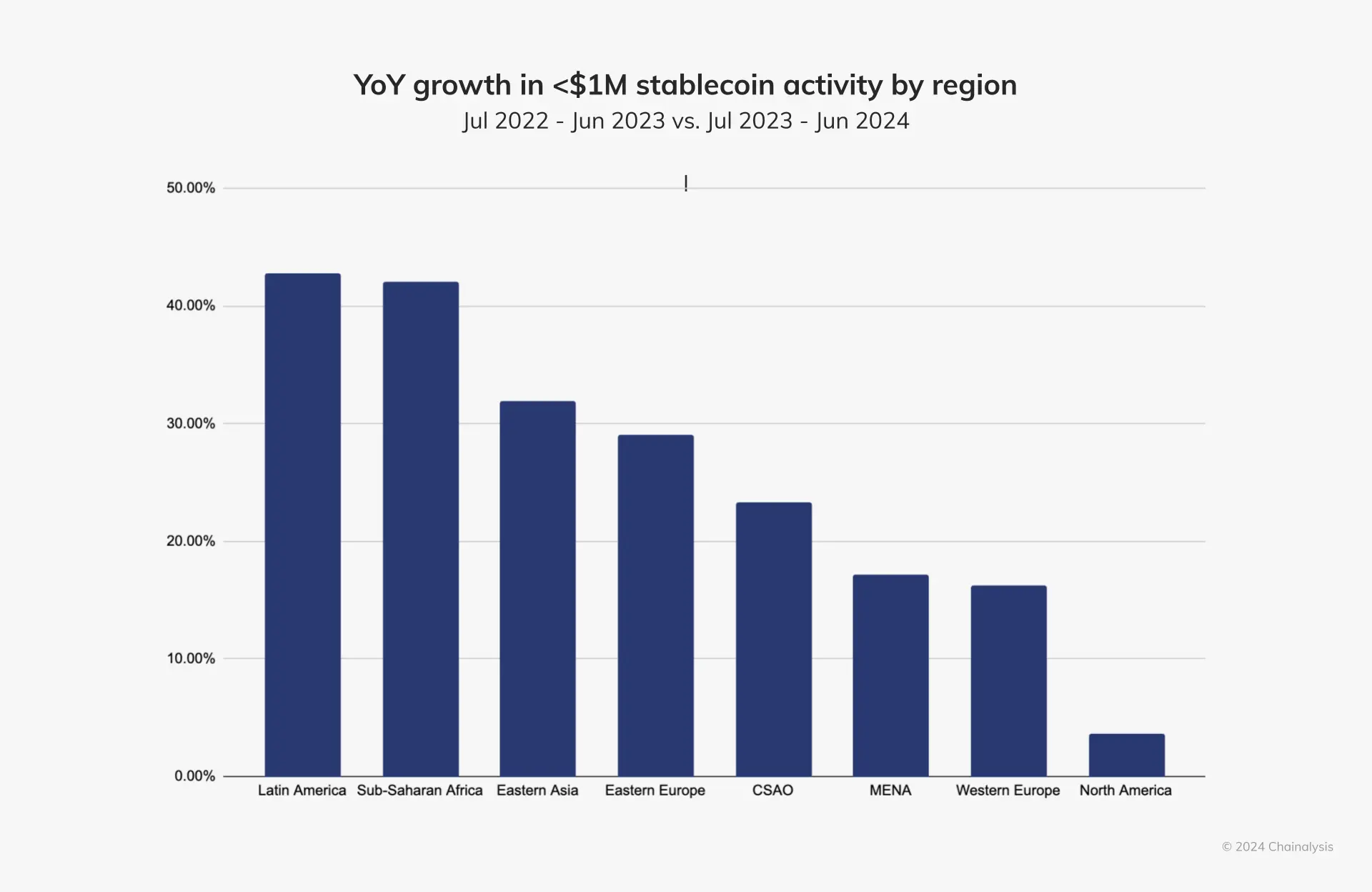
Latin America and Sub-Saharan Africa are the fastest-growing regions for retail and professional-scale stablecoin transfers, with year-over-year growth exceeding 40%. East Asia and Eastern Europe follow closely, with year-over-year growth rates of 32% and 29%, respectively.
Meanwhile, retail stablecoin activity in markets like North America and Western Europe has grown significantly, but at a slower pace, likely due to strong local financial infrastructure, although institutional investors in these regions are increasingly adopting stablecoins for liquidity management, settlement, and entry into cryptocurrencies. Notably, Western Europe is home to the world’s second-largest merchant services market, with the UK leading the region with a year-over-year growth rate of 58.4%. Stablecoins dominate these services, consistently capturing 60-80% of market share each quarter, as shown in the chart below.
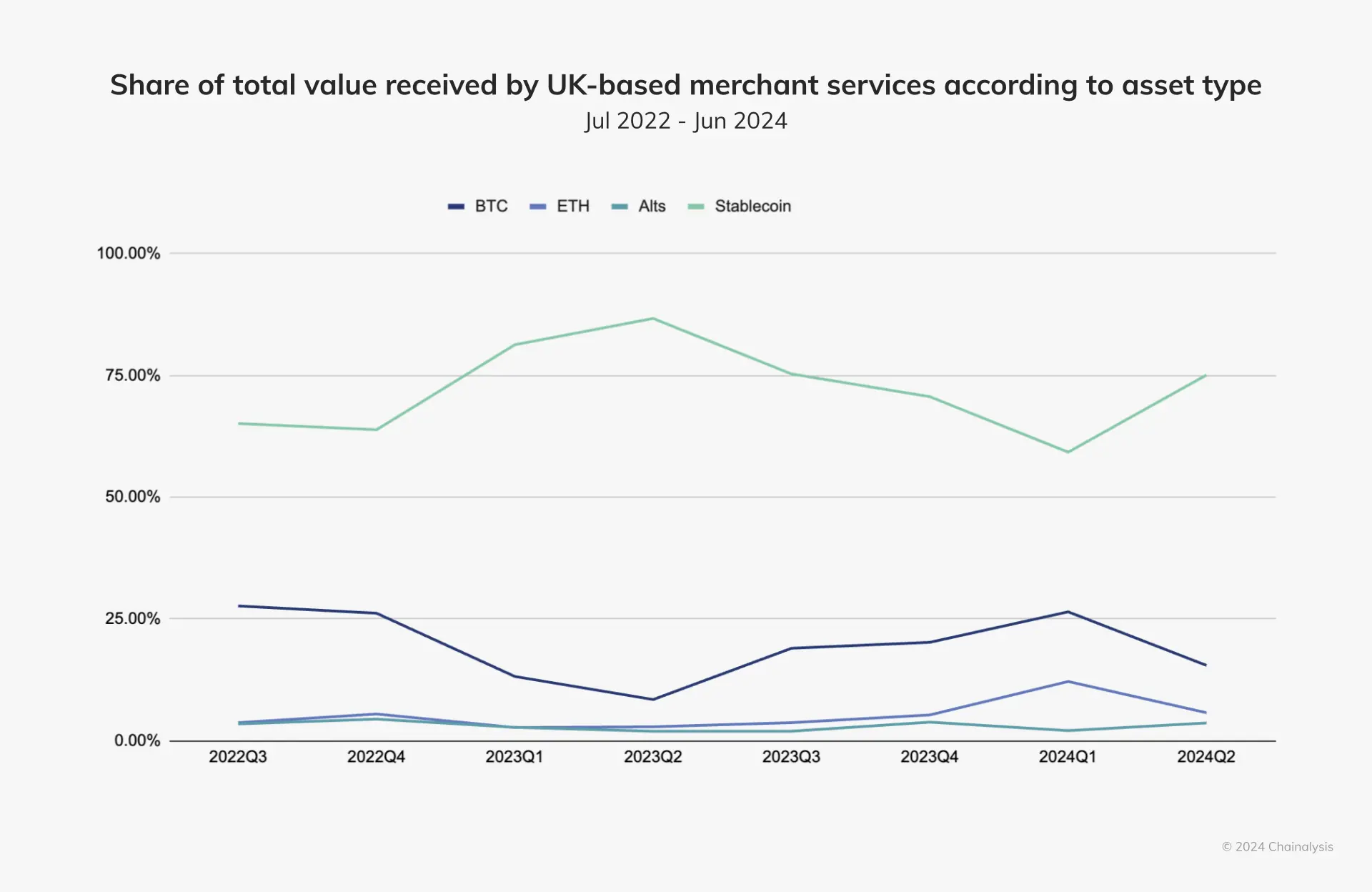
In the Middle East and North Africa, stablecoins and altcoins have captured a larger market share, surpassing traditional dominant assets like BTC and ETH, particularly in Turkey, Saudi Arabia, and the UAE.
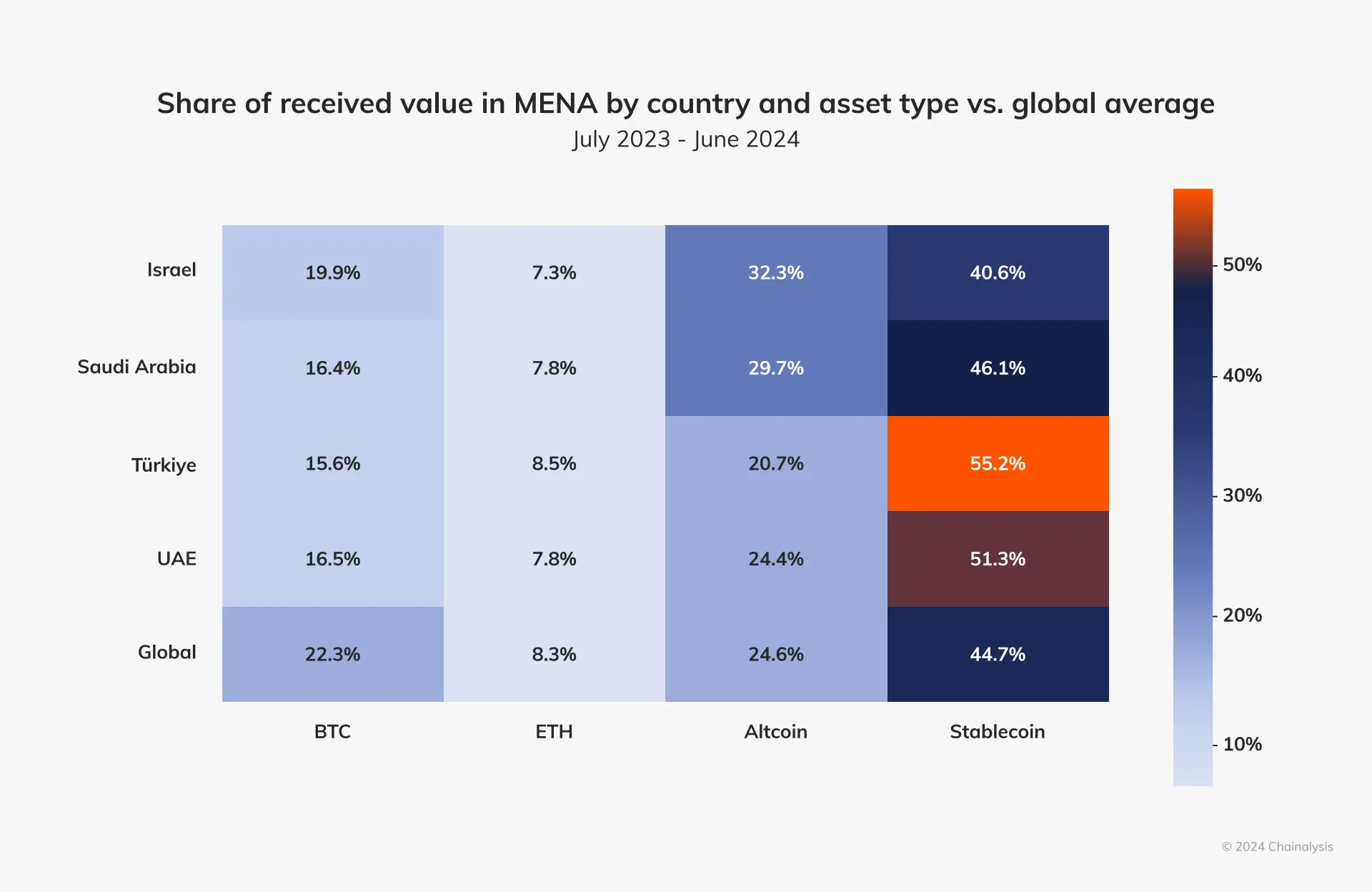
Notably, the volume of stablecoin transactions in Turkey far exceeds the proportion of GDP compared to the rest of the world.
In East Asia, interest in stablecoins surged among potential issuers following the launch of a stablecoin sandbox in Hong Kong. Upcoming stablecoin regulations will pave the way for stablecoins to be listed for retail trading, potentially bolstering Hong Kong's web3 ambitions.
In Central Asia, South Asia, and Oceania, stablecoins are widely used for cross-border trade and remittances, circumventing the challenges of traditional banking. Countries like Singapore have enhanced confidence in stablecoins through regulatory frameworks, making them important tools for both retail and institutional users.
Global Stablecoin Policies and Regulations
Stablecoins have become a priority for global regulators as they are rapidly adopted in the global financial system and play an increasingly important role in various use cases. Governments and regulatory bodies are working to address the challenge of creating frameworks that encourage innovation while ensuring consumer protection, financial stability, and compliance with anti-money laundering and counter-terrorism financing (AML/CFT) standards.
European Union (EU)
The European Union (EU) has introduced the Markets in Crypto-Assets Regulation (MiCA), aimed at creating a unified framework for crypto asset issuers and service providers (including stablecoins) within the EU. MiCA represents a significant shift from AML-focused regulation (introduced by the Fifth Anti-Money Laundering Directive) to a comprehensive regulatory framework establishing prudential and conduct obligations. MiCA focuses on enhancing consumer protection, ensuring market integrity, and maintaining financial stability. The stablecoin framework under MiCA will take effect on June 30, 2024, while regulations governing crypto asset service providers (CASPs) will come into effect on December 20, 2024. Although MiCA is a European regulation applicable to all 27 EU member states, the responsibility for licensing and supervising issuers and CASPs lies with their respective national authorities.
MiCA establishes two different types of stablecoins: (i) Asset-Referenced Tokens (ART), which aim to maintain stable value by referencing another value or a combination of rights, including one or more official currencies, commodities, or crypto assets; (ii) Electronic Money Tokens (EMT), which aim to maintain stable value by referencing the value of an official currency (such as the euro or US dollar). ART and EMT issuers within the EU must obtain the corresponding MiCA license, which includes publishing a detailed white paper and adhering to strict rules regarding governance, reserve asset management, and redemption rights.
EMTs (considered both crypto assets and funds) serve as a means of payment, while ARTs are viewed as a means of exchange, requiring issuers to report trading activities in more detail. Additionally, ARTs may be subject to issuance restrictions. Major stablecoins, referred to as "significant" stablecoins, face stricter regulations, including higher capital requirements and reserve asset obligations, directly overseen by the European Banking Authority (EBA) rather than national regulators. While MiCA has the potential to become a global standard, challenges such as unclear national implementation and overlapping classifications highlight the need for additional guidance to ensure smooth implementation and adoption.
Singapore
The Monetary Authority of Singapore (MAS) has completed the regulatory framework for stablecoins in the country, focusing on single-currency stablecoins (SCS) pegged to the Singapore dollar or any G10 currency in circulation in Singapore. The framework emphasizes value stability, capital adequacy, redemption, and disclosure to ensure prudent robustness and consumer protection. Stablecoin issuers that meet all the requirements of this framework can apply to be recognized as "MAS-regulated stablecoins."
Hong Kong
Hong Kong, as a special administrative region of China, has a different legal and regulatory framework from mainland China. This separation allows Hong Kong to develop progressive regulatory policies around stablecoins and other crypto assets. The Hong Kong Monetary Authority (HKMA) has established a regulatory framework for stablecoin issuers, acknowledging the rapid evolution of the digital currency landscape. Even as legislation nears completion, the HKMA has launched a sandbox that enables industry stakeholders with compelling use cases to develop and test their business models, facilitating two-way discussions on regulation and risk management. Three projects were included in the sandbox in July 2024.
Japan
Japan is one of the first countries in the world to establish a regulatory framework for stablecoins. This framework places a high emphasis on stability and oversight, allowing banks, trust companies, and money transfer service providers to issue fiat-backed stablecoins under strict reserve requirements. Reports indicate that large companies like Mitsubishi UFJ Financial Group (MUFG) are exploring stablecoin opportunities, but the market is still in its infancy, with no stablecoins listed on local exchanges or registered with electronic payment service providers (EPSPs). Recently, the Financial Services Agency of Japan has been reviewing stablecoin rules and considering international experiences.
United States
Stablecoin regulation in the United States is still ongoing, with significant uncertainty and controversy. While stablecoins like USDC and USDT are widely used for payments and financial services, the lack of a comprehensive regulatory framework poses challenges for both issuers and users. Initiatives to address this issue include proposed legislation, such as the stablecoin bill introduced by the House Financial Services Committee in 2023, which aims to establish clear rules for issuers regarding reserves, transparency, and anti-money laundering (AML) compliance.
Major Stablecoin Issuers
While there are currently hundreds of stablecoins in circulation, most are issued by Tether, followed by Circle. Other issuers, although with smaller market shares, are actively changing the landscape of stablecoins.
Tether (USDT)
Tether (USDT) is the largest stablecoin by market capitalization, accounting for the vast majority of stablecoin supply and providing liquidity for numerous blockchains. Tether's reserves and financial transparency have been under scrutiny, but the company asserts that audits and market stress tests validate its solid position. Tether holds nearly $100 billion in US Treasury bills, with most of its assets managed by Cantor Fitzgerald, making its reserve assets comparable to major countries. Tether continues to expand its product range, including UAE dirham-backed tokens and gold-backed stablecoins, focusing on the market for these assets that provide tangible value.
Circle (USDC)
Circle issues USDC, the second-largest stablecoin by market capitalization. USDC is known for its transparency, with its reserves being verified weekly. The reserves are held in cash and short-term US government bonds, providing users with a high level of transparency and assurance.
Paxos
Paxos issues Pax Dollar (USDP) and provides infrastructure for PayPal's stablecoin PayPal USD (PYUSD) and other global stablecoin projects. Paxos emphasizes transparency and trust, adhering to portfolio management guidelines and publishing monthly attestation reports to verify reserves.
PayPal (PYUSD)
PayPal has entered the stablecoin market with PayPal USD (PYUSD), issued in partnership with Paxos. PYUSD is designed for payments and is backed by reserves managed by Paxos, with regular transparency reports provided to the public.
Use Cases for Stablecoins
Stablecoins were once primarily used for cryptocurrency trading but have now become versatile tools for everyday use cases, providing extensive utility for both the crypto-native ecosystem and TradFi.
Gateway to DeFi
Stablecoins are the backbone of many DeFi protocols, facilitating lending and yield farming. They are ideal for liquidity pools due to their lack of price volatility, which can reduce impermanent loss and maintain the efficiency of decentralized exchanges (DEXs). Stablecoins also enable global financial services, allowing users in economically unstable regions to participate in DeFi markets without bearing the brunt of local currency fluctuations.
Payments and Peer-to-Peer (P2P) Transactions
Stablecoins are increasingly used for everyday payments and P2P transfers. They can process transactions quickly and cost-effectively compared to traditional banking systems, often incurring minimal fees, making them an attractive option for users. In P2P transactions, stablecoins provide individuals with a simple and secure way to exchange value without intermediaries. This is especially valuable in regions where reliable banking systems are unavailable.
Cross-Border Transactions and Remittances
Cross-border payments and remittances are among the most transformative use cases for stablecoins. They offer a faster and cheaper alternative to traditional remittance services, which often involve high fees and slow processing times. Migrant workers (often unbanked or underbanked) use stablecoins to send money home, while businesses use them to settle international invoices. Stablecoins provide a solution to bypass the inefficiencies of traditional financial systems, enhancing financial inclusion and reducing friction in cross-border transactions.
For example, using stablecoins to send $200 from Sub-Saharan Africa is approximately 60% cheaper compared to traditional fiat-based remittance methods, as shown below.

Foreign Exchange (FX) and Trade Financing
For foreign exchange and trade financing, stablecoins enable businesses to transact in globally accepted digital currencies, reducing reliance on intermediaries and lowering risks associated with exchange rate fluctuations. Stablecoins simplify transactions for importers and exporters, providing a stable and transparent medium for international trade, especially in regions with limited access to foreign exchange.
Value Storage in Economic Instability or Inflation
Stablecoins have become the preferred means of value storage in regions facing economic instability or high inflation. By pegging their value to assets like the US dollar, stablecoins offer individuals and businesses a way to maintain purchasing power and protect their assets from local currency fluctuations. This use case is particularly effective in emerging markets, where access to stable financial instruments is limited and there is a strong need for direct access to US dollars.
Stablecoins often trade at a premium in high-inflation areas, reflecting users' willingness to pay for stability and faster capital movement. Currency instability in emerging markets can lead to significant GDP losses over time, further driving demand for stablecoins.
Illicit Activities in the Stablecoin Ecosystem
While stablecoins have gained significant attention for their legitimate use cases, they are also exploited by high-risk and illicit actors for various illegal activities. Their stability and global accessibility make them attractive tools for bad actors attempting to circumvent financial controls and avoid detection—though the inherent transparency and traceability of blockchain often make this a poor choice.
While we estimate that less than 1% of on-chain transactions are illicit, stablecoins have been used for activities such as money laundering, fraud, and evading sanctions. Due to their relatively high liquidity and acceptance on cryptocurrency exchanges, stablecoins can facilitate rapid cross-border value transfers without relying on traditional financial institutions.
Using Stablecoins to Evade Sanctions
As countries like Russia explore alternatives to bypass Western financial restrictions, the practice of evading sanctions through stablecoins and other cryptocurrencies has become increasingly prominent. Entities in sanctioned regions may use stablecoins to facilitate international trade or transfer funds to entities in non-sanctioned jurisdictions. These activities exploit the anonymity of blockchain transactions to obscure the source of funds, often through complex networks of wallets and exchanges. Although large-scale sanction evasion remains challenging due to liquidity constraints in the cryptocurrency market and the transparency of blockchain transactions, smaller-scale activities (such as fund transfers involving sanctioned entities and politically exposed persons) pose security and compliance risks.
How Stablecoin Issuers Collaborate with Law Enforcement
Stablecoin issuers are ramping up efforts to combat financial crime, supporting global law enforcement and regulatory investigations. Issuers like Tether work closely with global law enforcement agencies, financial crime units, and regulators such as the Financial Crimes Enforcement Network (FinCEN), using Chainalysis to monitor transactions in real-time and identify suspicious activities. Most centralized stablecoin issuers also have the authority to freeze or permanently delete or "burn" tokens in wallets associated with confirmed criminal activities, thereby preventing illegal transactions and aiding in the recovery of stolen funds.
Which Stablecoin Issuers Can Burn and Freeze Tokens?
Stablecoins issued by centralized services, such as USDC (Circle), USDT (Tether), BUSD (Paxos), and TUSD (Techteryx), can be frozen or burned by their issuers to comply with regulations or prevent illegal activities. In contrast, decentralized stablecoins, such as DAI (MakerDAO), FRAX (Frax Finance), and LUSD (Liquity), are governed by protocols and smart contracts, thus not subject to freezing or burning by any centralized authority. Balancing compliance and user autonomy is an important consideration in decentralized technology.
The Future of Stablecoins
Stablecoins not only represent a critical intersection between blockchain and traditional financial systems but also open new avenues for economic participation. Supported by regulatory advancements aimed at providing clarity and building trust between users and institutions, adoption rates continue to grow across various regions and industries. As frameworks like Europe’s MiCA and guidelines from markets like Singapore and Japan gradually take shape, stablecoins will gain further legitimacy and integrate into the mainstream financial system.
The future of stablecoins is not without challenges. Regulatory uncertainty in major markets, exploitation by illicit actors, and issues surrounding reserve transparency persist, and if not effectively addressed, these issues could undermine market confidence and hinder broader adoption. On the other hand, stablecoins offer tremendous opportunities for financial inclusion, particularly in underserved areas, and are actively revolutionizing payments, remittances, and trade financing by lowering costs and increasing speed. The role of stablecoins in creating new financial products and simplifying cross-border trade further underscores their transformative potential.
With ongoing advancements in regulation and technology, stablecoins have the potential to unlock new opportunities, bridging gaps between economies and achieving greater global financial connectivity. Their continued evolution will play a central role in defining the future of cryptocurrencies and TradFi.
免责声明:本文章仅代表作者个人观点,不代表本平台的立场和观点。本文章仅供信息分享,不构成对任何人的任何投资建议。用户与作者之间的任何争议,与本平台无关。如网页中刊载的文章或图片涉及侵权,请提供相关的权利证明和身份证明发送邮件到support@aicoin.com,本平台相关工作人员将会进行核查。




